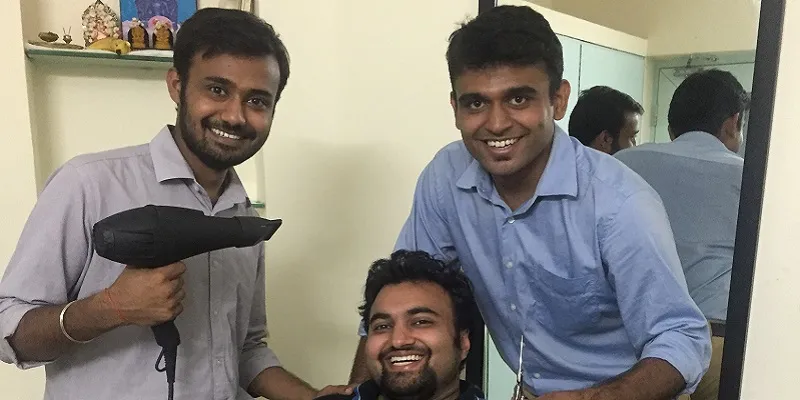With over 30 percent MoM growth, Stayglad aims to capture the Rs 25,000 crore beauty services market
It has been a rather rough and long week at work. Nothing seems better than getting a nice facial, pedicure, and a complete beauty makeover. But the idea of driving in traffic seems exhausting and you hanker for quality beauty services at home. It is to cater to this very need that Stayglad – a platform for on-demand, at-home beauty services – was started.
Prateek Jain knew that the beauty services market was big in India, but was unsure how much of a problem it actually was in the modern Indian context. But when he noticed the challenges his wife faced with scheduling salon appointments around their busy schedule that he realised he was onto something. “Beauty services is a recurring need, and if one has to wait for the weekend to get their basic grooming needs fulfilled it is a problem. Especially for the working professionals, busy mothers, and even busy housewives,” adds Prateek.
From manufacturing to beauty services
An IIT Kharagpur graduate, for one year after graduating, Prateek worked at a manufacturing setup for Heinz ketchup. Realising that he wanted to startup on his own, he moved to Urbantouch, where he worked as the category manager for fashion jewellery. This is where he learnt more about women’s consumer behaviour and shopping patterns. After Urbantouch got acquired, Prateek quit and worked at Amazon as a category manager for Junglee.com.
When Prateek decided to start Stayglad, he roped in IIT Kharagpur classmates Kavish Desai and Shashank Gupta, who were working at Flipkart and Adobe, respectively. But three men setting up a beauty services business for women was wrought with its own challenges.

We would sit outside women’s salons and wait for the professionals to come out to talk to them and sell our idea. We would ask them whether they would be interested in this, the challenges they were facing and how this would make their lives easier,” adds Prateek.
After talking to multiple women professionals and customers, they realised there were enough problems for them to solve. Prateek, however, adds that being men also gave the team an advantage of having zero bias in the space. He says every time they have a roadblock, they would refer back to their customers and other women.
Breaking the asset-heavy model
In a salon, the growth trajectory for women is limited, because the business is asset heavy and unlike other industries, additional experience doesn’t necessarily mean higher pay. This, in turn, leads to a higher churn rate. Most stylists end up opening their own salon, which again is an asset-heavy model. With a model like Stayglad, professionals can work without having to invest heavily on assets.
After onboarding the first set of professionals outside parlours and salons, the team soon were able to tap into the referral network. There is an in-house beauty and subject matter expert team who whets the professionals onboarded to the platform.
Currently, a customer can go on the website or the app and choose whatever service they want, put in their address and time slot. This request goes to a central term, who send it to the service provider. The service provider gets the request, calls the customer, adds or deletes a service request, if needed, and even books an Uber to get to the service provider’s place.

Deciphering the market
Going forward, the service can manage inventory, calendar, products and customer base. As of April this year, the team were doing over 300 orders per day and were growing at 30 per cent month on month, with a revenue of close to Rs.50,00,000 per month. The team has also raised a Series A funding.
While there has been talk about the crunch that on-demand startups are facing, and even with the shutting down of Amber Wellness, Stayglad claims to be doing consistently well and steady. Anil Chopra, former CEO Lakme Lever, who now is on the board and part of Stayglad team, says the salon industry is a Rs. 25,000 crore market.
Parts of the salon services industry are bigger than some FMCG categories like skin or hair care. Also it is a market that is growing at over 20 per cent year on year, adds Anil.
Nevertheless, if you look at the market, nearly 60 percent of this space is unorganised and run by several mom and pop beauty parlours. This means that there is a growing and latent demand for these services. Anil says that 20 per cent is value growth, which means that there are more people willing to pay for the services and are evolving.
Today there are many players in this space such as Bulbul, Belita, VanityCube, Makeoverz and Getlook, and others are looking for a foothold. Several players have raised funds such as Belita from India Quotient, Vyomo from YouWeCan and Rocket Internet and Vanity Cube from unnamed investors. Close to 60 per cent of startups in the on-demand beauty space had raised money at the seed level.
All about the value
Prateek adds that the business is about learning and growing with the value that the customer needs. In the beginning, the team would provide cabs to the service providers and now it is more self-service. The idea is to make professionals self-reliant and give them whatever support is needed from the backend.
Stayglad now works on a full-stack model, where the service provider gets a minimum guarantee. The long term plan is to look at a percentage commission from the revenue service providers get. “Being in the beauty services industry, the customer service experience is critical, so we track the user experiences very strongly and tightly. When it comes to beauty services, the customers aren’t price sensitive, especially if you can deliver the value. Currently, we are looking to expand deeper in the city before touching other metros,” adds Prateek.







